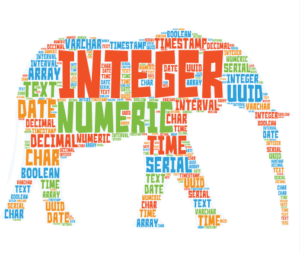September 27, 2023
Summary: in this tutorial, you will learn about PostgreSQL data types including Boolean, character, numeric, temporal, array, json, uuid, and special types.

Table of Contents
Overview of PostgreSQL data types
PostgreSQL supports the following data types:
- Boolean
- Character types such as
char,varchar, andtext. - Numeric types such as integer and floating-point number.
- Temporal types such as date, time, timestamp, and interval
- UUID for storing Universally Unique Identifiers
- Array for storing array strings, numbers, etc.
- JSON stores JSON data
- hstore stores key-value pair
- Special types such as network address and geometric data.
Boolean
A Boolean data type can hold one of three possible values: true, false or null. You use boolean or bool keyword to declare a column with the Boolean data type.
When you insert data into a Boolean column, PostgreSQL converts it to a Boolean value
1,yes,y,t,truevalues are converted totrue0,no,false,fvalues are converted tofalse.
When you select data from a Boolean column, PostgreSQL converts the values back e.g., t to true, f to false and space to null.
Character
PostgreSQL provides three character data types: CHAR(n), VARCHAR(n), and TEXT
CHAR(n)is the fixed-length character with space padded. If you insert a string that is shorter than the length of the column, PostgreSQL pads spaces. If you insert a string that is longer than the length of the column, PostgreSQL will issue an error.VARCHAR(n)is the variable-length character string. WithVARCHAR(n), you can store up toncharacters. PostgreSQL does not pad spaces when the stored string is shorter than the length of the column.TEXTis the variable-length character string. Theoretically, text data is a character string with unlimited length.
Numeric
PostgreSQL provides two distinct types of numbers:
- integers
- floating-point numbers
Integer
There are three kinds of integers in PostgreSQL:
- Small integer (
SMALLINT) is 2-byte signed integer that has a range from -32,768 to 32,767. - Integer (
INT) is a 4-byte integer that has a range from -2,147,483,648 to 2,147,483,647. - Serial is the same as integer except that PostgreSQL will automatically generate and populate values into the
SERIALcolumn. This is similar toAUTO_INCREMENTcolumn in MySQL orAUTOINCREMENTcolumn in SQLite.
Floating-point number
There three main types of floating-point numbers:
float(n)is a floating-point number whose precision, at least, n, up to a maximum of 8 bytes.realorfloat8is a 4-byte floating-point number.numericornumeric(p,s)is a real number with p digits with s number after the decimal point. Thenumeric(p,s)is the exact number.
Temporal data types
The temporal data types allow you to store date and /or time data. PostgreSQL has five main temporal data types:
DATEstores the dates only.TIMEstores the time of day values.TIMESTAMPstores both date and time values.TIMESTAMPTZis a timezone-aware timestamp data type. It is the abbreviation for timestamp with the time zone.INTERVALstores periods of time.
The TIMESTAMPTZ is the PostgreSQL’s extension to the SQL standard’s temporal data types.
Arrays
In PostgreSQL, you can store an array of strings, an array of integers, etc., in array columns. The array comes in handy in some situations e.g., storing days of the week, months of the year.
JSON
PostgreSQL provides two JSON data types: JSON and JSONB for storing JSON data.
The JSON data type stores plain JSON data that requires reparsing for each processing, while JSONB data type stores JSON data in a binary format which is faster to process but slower to insert. In addition, JSONB supports indexing, which can be an advantage.
UUID
The UUID data type allows you to store Universal Unique Identifiers defined by RFC 4122 . The UUID values guarantee a better uniqueness than SERIAL and can be used to hide sensitive data exposed to the public such as values of id in URL.
Special data types
Besides the primitive data types, PostgreSQL also provides several special data types related to geometric and network.
box– a rectangular box.line– a set of points.point– a geometric pair of numbers.lseg– a line segment.polygon– a closed geometric.inet– an IP4 address.macaddr– a MAC address.
In this tutorial, we have introduced you to the PostgreSQL data types so that you can use them to create tables in the next tutorial.

